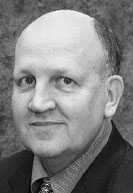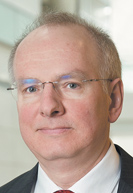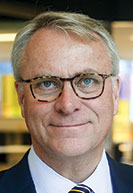Subscriber Benefit
As a subscriber you can listen to articles at work, in the car, or while you work out. Subscribe NowIt has no employees, no higher-education accreditation and only about $40,000 in the bank.
But a group of physicians and business leaders, many with ties to DePauw University in Greencastle, is quietly drawing up plans to establish a medical school in Indiana with a focus on global health.
The not-for-profit Tumaini Foundation for Global Health and Humanitarianism says it wants to train medical students with a special concern for the health of needy individuals and populations worldwide. That includes rural and inner-city areas in Indiana as well as impoverished, developing nations.
“Indiana needs more physicians, particularly physicians that would be inclined to practice in low-resource settings,” said Dr. Thomas Mote, a semi-retired anesthesiologist who is president of the Tumaini board.
The Indianapolis-based group has not made an official announcement about where it plans to set up a school or how it plans to raise tens of millions of dollars.
But in several discussions with IBJ in recent weeks, the organization’s leaders say the need is huge, and they hope they can persuade a wealthy individual or foundation to make a sizable donation to get the ball rolling. The group has yet to approach a large foundation or wealthy person to land a major donation.
“It’s not a goal that we just think of as being in the clouds,” said Kathleen Jagger, president of Newman University, a private, Catholic college in Wichita, Kansas, and a Tumaini board member. “…The big challenge right now is selling the idea, helping people understand [that] the way we traditionally think about medicine in the U.S. has some limitations.”
The group’s twofold mission is to make health care accessible to all and to help alleviate disparities, often in low-income communities, that lead to lower life expectancy and higher rates of disease.
Examples include poor sanitation, unsafe neighborhoods, and a lack of healthy food and access to medical care—a group of factors often classified as “upstream determinants of health.”
Indiana’s third med school?
If successful, the medical school would be just the third in Indiana—after the Indiana University School of Medicine, established in 1903, and the Marian University College of Osteopathic Medicine, which opened its doors more than a century later, in 2013.
Yet around the country, at least nine institutions in recent years have announced plans to open medical colleges, including Duquesne University in Pittsburgh; Marist College in Poughkeepsie, New York; and the University of Texas at Tyler.
From 2001 to 2019, 29 medical colleges opened in the United States, according to a count in early 2020 by the Association of American Medical Colleges that was reported by Inside Higher Ed, an industry newsletter.
Even so, across the nation, the supply of physicians is expected to fall short of the need, as many doctors retire and the nation’s aging population, which is living longer, needs more health care.
Overall, the U.S. will see a shortage of up to nearly 122,000 physicians by 2032 as demand for physicians continues to grow faster than supply, the AAMC said in a 2019 study.
And that’s where the Tumaini Foundation (“Tumaini” is Swahili for “hope”) sees an opportunity. It hopes to persuade donors and the public to support its mission of setting up a medical school that would not focus on high-income ZIP codes, where many new doctors open clinics, but in the needy and neglected areas, where the looming shortage of doctors could hit the hardest.
And instead of treating populations one patient at a time, it hopes to address the causes of inadequate medical care.
“Our ultimate goal would be to have a medical school that is focused on public health rather than the treatment of individuals,” said Jeff Lewis, a retired partner at the Indianapolis law firm Ice Miller LLP, and a board member of Tumaini.
The organization’s plans might strike some in the medical community as new and audacious. But the group has been active about a decade, perhaps under the radar, offering undergraduate classes and seminars on global health at local colleges, including Butler University, DePauw University, Wabash College and IUPUI.
Its leaders also have accompanied undergraduates on medical trips to Guatemala, Ecuador, Ghana and other developing countries.
They say their goal of establishing a medical school is long-range and aspirational. But slowly, a plan is coming together.
Turning the group’s dream into reality most likely will take tens of millions of dollars and at least five years of work to clear numerous hurdles, such as gaining accreditation, hiring faculty, securing space and finding a hospital system to help it train its students—all of which are just plans on paper at the moment.
The Tumaini Foundation shared its business plan and projected budget spreadsheets with IBJ, which give a window into its ambitious idea.
The proposal calls for hiring up to 30 faculty members and five administrators along with other staff over six years. The curriculum would cover the typical medical school subjects of anatomy, biochemistry, immunology, pharmacology and pathology. It might also include such topics as “neglected tropical diseases” and economics of poverty.
“We would enlist the help of public and global health experts to create an innovative curriculum, marrying traditional medical school instruction on caring for an individual and public health’s concern with the health of populations and addressing upstream determinants of health,” the proposal reads.
The group has not finalized a site for the new school, although it said the college would likely be somewhere in Indianapolis or Greencastle, probably in rental space at first.
According to the budget plans, expenses would amount to $1.04 million in the first year with a small faculty, a figure that would climb to $18.7 million by the sixth year, as the school hired more instructors.
The school would break even financially by the sixth year, with revenue coming from tuition, application fees and other sources, according to the plans.
The goal is to start with 50 students in the first class and ramp up to 100 students a year, for a student body of about 400.
That would make it smaller than Indiana’s two other medical schools. Indiana University School of Medicine has about 1,400 students. Marian University College of Osteopathic Medicine has about 650.
Is it needed?
Officials at IU said they are already focused heavily on population health, and that they train physicians to improve the health of communities, not just treat patients. The school’s rural medicine program, based at the Terre Haute campus, emphasizes primary care and other specialties of need in rural communities. Its urban medicine program, based at the Gary campus, offers training to provide care for underserved communities in urban settings.
“As the largest school of medicine in the U.S., we are focused on training globally minded physicians, researchers and educators and improving population health in Indiana, across the country and throughout the world,” Dr. Jay Hess, dean of the IU School of Medicine, said in a written statement to IBJ. “Our long-standing work in health care practice, policy and research impacts lives in more than 10 countries on four continents.”
IU officials also pointed to their Center for Global Health, which runs several programs, notably its AMPATH Partnership with Moi University School of Medicine in Kenya for more than 30 years.
Yet Tumaini officials say their program would be fully aimed at global health—a broad term that basically means improving health and achieving equity in health for all people worldwide.
Mote, who got his medical degree from Case Western Reserve University, a private university in Cleveland, said IU offers good global health studies. “But for medical students, it is a sidelight where they can visit in the summer and do a four-year elective rotation,” he said. “Tumaini’s medical school would have global health in our DNA.”
Meanwhile, officials at Marian University called Tumaini’s goal of setting up a medical school focused on global health “very noble,” but questioned whether it was truly needed.
“I’m not too sure Indiana needs another medical school,” said Daniel Elsener, Marian University’s president. “…It’s easier to expand a medical school than to start one.”
Elsener said it cost Marian University more than $200 million to set up its osteopathic medical school, hire faculty and enroll students. He said forming partnerships with community leaders made all the difference, including senior executives at drugmaker Eli Lilly and Co. and several hospital systems, including St. Vincent Health (now Ascension St. Vincent) and Community Health Network.
“In a big city like this, we had great partnerships and a lot of community connections,” he said. “That’s the only way it was possible.”
No question, setting up a medical school is a long, expensive process, often costing hundreds of millions of dollars and taking up to 10 years.
Perhaps the biggest challenge at the outset is to find a wealthy individual or foundation who will donate tens of millions of dollars to a startup university.
“That’s our problem now,” Mote acknowledged. “How do we get credibility, find that one person who’s passionate about this?”
But some of its board members point out that new medical schools have a good record of attracting large donations.
Belmont University, a private Christian college in Nashville, recently landed several gifts of $10 million each, including one from the former CEO of HCA Healthcare, who chairs the Belmont board.
“So you’re just one donor away from making a big difference,” said Dr. Michael Christie, an orthopedic surgeon in Nashville specializing in total joint replacement, and a member of the Tumaini board. “Maybe that’s a member of the Lilly family. Indianapolis has a very long history of philanthropy, with strong companies and families donating back to their community. And what better way than to have another medical school in Indiana?”
Another big hurdle is getting accreditation from two major groups: the Licensing Committee on Medical Education and the Higher Learning Commission. One possible shortcut is to become part of an existing university, but the Tumaini group said that is not part of its plan.
“We do not want to do this as it has the potential to dilute our mission and makes administration cumbersome and slow,” the group’s business plan says. “Tumaini prefers to … become a health sciences university where we would also offer a post-baccalaureate masters of medical science degree to students trying to get into medical school.”
High-powered board
Despite the lack of funding and its go-it-alone stance, what Tumaini seems to have going for it is a board filled with high-credentialed, and perhaps well-connected, professionals.
The board includes physicians, a college president, professors at Harvard and Yale medical schools, and officials in real estate, insurance and humanitarian networks.
Many of them have been guest speakers at Indiana colleges or have attended college or graduate school together. Several—including Mote, Jagger and Christie—were undergraduates together at DePauw and have kept in touch through their shared interest in public health. (DePauw is not officially connected to Tumaini nor to its efforts to set up a medical school.)
Dr. Thomas Burke, chief of the division of global health and human rights at Massachusetts General Hospital, sits on the Tumaini board and said he is happy to help raise funds and support the effort.
He said his students at Harvard Medical School, where he is associate professor of surgery, have shown a hunger to do more for the cause of global health.
“It’s more than just going and spending a month in a country somewhere, or spending time with poor people,” Burke said. “It’s really about understanding the complexity of what it means to be engaged in a lifelong commitment of making a difference in the lives of poor people.”•
Please enable JavaScript to view this content.






Finally there is movement to get another medical school started in Indiana!
Regardless of the comments from the other two medical schools in Indiana [one allopathic (A) and one osteopathic (O)], Indiana is in is dire need of more trained physicians for our State. Even from the sheer numbers, describing the number of such schools in our surrounding neighbors, is eye-opening:
Illinois 7 (A) and 1 (O)
Michigan 5 (A) and 1 (O)
Ohio 6 (A) and 1 (O)
Kentucky (A) and 1(O)
All of those state are training more physicians and have more residency programs than Indiana. Besides that, which is also part of part of these programs, much more vibrant and productive bio-medical research programs. As an additional byproduct, those programs are more closely working with the biomedical private industry (e.g. pharmaceutical, medical device, etc., etc., etc.) Regardless of the many local cheerleader, biomedical, organizations which give one the false impression of the widely successful biomedical research environment of State, Indiana is just nowhere near being able to compete with top tier programs. It does not have to be that way IF we had more medical schools (both types) and more residency programs. I have been saying that for years that both Purdue and Notre Dame have the resources to have their own schools. They already have some of the infrastructure and resources in place. They are already have well established research programs.
I would suggest to the group trying to start a new medical school to consider partnering with Notre Dame and/or Purdue rather than trying to build one from scratch.
Indiana is in dire need of more trained physicians for all of citizens of our State. Unfortunately, public health and health care in general have been TOTALLY neglected for many, many years. There should be more of a moral outrage by us, citizens of Indiana, to demand more from the political establishment of our State.
Phillip D. Toth, MD, FACP
This sounds very “pie in the sky”-ish…. opening a medical school is a humongous undertaking.